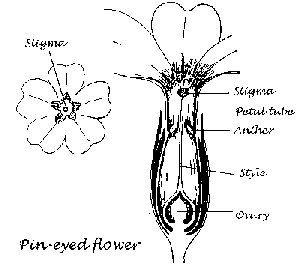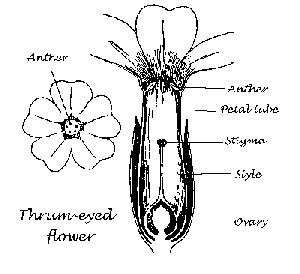What's in a Cowslip?
As with several of the early field meetings this year, the meeting on the 8th May at Pilch Field was cold, but a good number of members turned up at the start. Some soon left! To take minds off the weather and to turn attentions to the fine display of cowslips, a task was set.
Most flowering plants have stamens and ovaries in the same flower. A few have the organs in separate flowers on the same plant (e.g. hazel), whilst others have separate male and female plants (e.g. stinging nettle).
Pollination is an integral part of the reproductive process, transferring pollen from anthers to stigmas. A whole range of mechanisms has evolved to ensure that pollination takes place and to discourage self-pollination. Heterostyly, as found in cowslips, is an example of the latter. Here, two flower types exist with readily observed differences
|
|
|
The style, which links the ovary to the stigma, comes in two lengths - long and short! Pin-eyed flowers have a long style with a pin-head like stigma, which is clearly visible in the throat of the petal tube, at the top. Thrum-eyed flowers have a short style and a ring of anthers appears in the throat of the petal tube. Normally, pollination is with the pollen from pin-eyed going to thrum-eyed and vice versa. Pin/pin and thrum/thrum pollination does not occur - or if it does, no seeds are produced as a result.
The inheritance of pin-eyed and thrum-eyed flowers is genetically determined, pin being recessive (and hence homozygous) and thrum always heterozygous. So, if t represents the allele of the gene determining pin-eye, then a homozygous pin-eyed parent may be represented by tt. Similarly, the heterozygous, thrum-eyed parent may be represented by Tt. Hence: Tt x tt gives Tt, Tt, tt and tt. So half of the offspring will have pin-eyed flowers and half thrum-eyed.
To see if the Pilch Field population of cowslips fitted this hypothesis, each Society member present was asked to sample at least ten plants and determine whether the flowers were pin-eyed or thrum-eyed. As it was they got carried away and 585 plants were counted! Of these, 285 were pin-eyed and 300 thrum-eyed. Theoretically, 292.5 of each type should have been found. Were our results significant?
A chi-square test was performed on the results and a probability value of 0.025 resulted. This means that the deviation from the expected is due, at least in part, from factors other than chance (i.e. the genetics outlined above). So, thanks to all of those who participated in the exercise: the results show that the sampled population is quite normal. Maybe we should have known that before we started!

